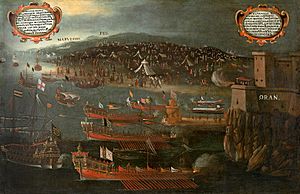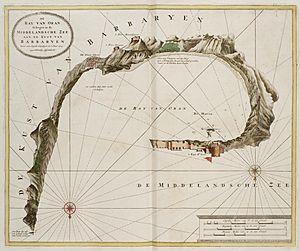Sieges of Oran and Mers El Kébir facts for kids
Quick facts for kids Sieges of Oran and Mers El Kébir |
|||||||
|---|---|---|---|---|---|---|---|
| Part of the Ottoman-Habsburg wars | |||||||
 Oran's harbour. Painting of 1613 by Vicente Mestre. |
|||||||
|
|||||||
| Belligerents | |||||||
| Regency of Algiers Kingdom of Ait Abbas Kingdom of Kuku |
|||||||
| Commanders and leaders | |||||||
| Alonso de Córdoba Martín de Córdoba Francisco de Mendoza y Vargas |
Hasan Pasha Jafar Catania |
||||||
| Strength | |||||||
| 1,500 men 90 guns |
25,000 men 30 galleys 15 galliots and fustas 5 carracks |
||||||
| Casualties and losses | |||||||
| Unknown | Heavy human losses, 5 galliots captured, 4 carracks captured |
||||||
The Sieges of Oran and Mers El Kébir happened between April and June 1563. This was a big fight between the Regency of Algiers and Spain. The Regency of Algiers wanted to take back two important Spanish military bases. These bases were Oran and Mers el Kébir, located on the coast of North Africa. Spain had controlled them since 1505.
This conflict was a key part of the larger Ottoman-Habsburg wars in the Mediterranean Sea. The army of Algiers was led by Hasan Pasha. He was the son of the famous pirate Hayreddin Barbarossa. Jafar Catania also helped lead the forces. Their army included soldiers from the Kingdom of Algiers and other local tribes.
The Spanish forces were led by two brothers: Alonso de Córdoba and Martín de Córdoba. They managed to defend the strongholds of Oran and Mers El Kébir. A Spanish relief fleet, led by Francisco de Mendoza, arrived just in time. This fleet helped defeat the attack and secure a Spanish victory.
Contents
Why the Sieges Happened
In the 1500s, the Ottoman Empire was growing stronger. They had already captured Tripoli in 1551. They also took Bougie in 1555. This meant that Oran and Mers El Kébir were some of the last Christian strongholds in North Africa. These cities were important because they helped stop Ottoman and Moorish pirates. These pirates often attacked ships along the coasts of Italy and Spain.
In 1556, an Ottoman fleet tried to capture Oran and Mers El Kébir. However, the Ottoman Sultan Suleiman ordered his ships to leave. He needed them for other battles in the Eastern Mediterranean. This allowed Spain to keep control of the cities, even though they were not well defended.
Planning the Attack
By 1562, Hasan Pasha was the Ottoman governor of Algiers. He decided it was time to take Oran and Mers El Kébir for Algiers. King Philip II of Spain found out about this plan. He quickly ordered a fleet to gather in Barcelona. This fleet was meant to bring 4,000 soldiers to reinforce the Spanish bases.
However, a terrible storm hit the Spanish fleet on October 19, 1562. This event is known as the La Herradura naval disaster. Most of the ships sank, and many soldiers and sailors died. This included Don Juan de Mendoza, a top Spanish naval commander.
Ottoman Preparations
After the Spanish disaster, Sultan Suleiman told Hassan Pasha to prepare his attack. Hassan Pasha gathered a huge army of 100,000 men. This army included Turks, Algerians, and many Janissaries (elite Ottoman soldiers). A large fleet also supported them from the sea. This fleet had 30 galleys, 5 French ships, and 15 smaller vessels. Jafar Catania, the governor of Tlemcen, commanded this fleet.
With these forces, Hassan Pasha marched towards Mers El Kébir. He believed capturing Mers El Kébir was key to taking Oran. Meanwhile, the Spanish commanders, Alonso and Martin de Córdoba, received some supplies. They got gunpowder, tools, and a few soldiers from Málaga. To help Oran and Mers El Kébir support each other, they built two new forts. One was San Miguel, located on a hill between the two cities. The other was Todos los Santos, facing Mers El Kébir.
The Siege Begins
The siege started on April 3, 1563. Ottoman troops launched a massive attack on the tower of Todos los Santos. About 200 Spanish soldiers defended this fort. The Spanish fought bravely, and artillery from Mers El Kébir helped them. They caused many casualties among the attackers.
However, the Ottoman cannons eventually broke down the walls. The fort was soon captured. At the same time, Jafar's ships blocked Mers El Kébir. This stopped any help from reaching the city from Oran. The Ottomans wanted to capture Mers El Kébir first. They had heard that the Spanish planned to leave Oran to focus on defending Mers El Kébir. So, Hassan Pasha sent most of his troops to attack San Miguel fort. This fort was a very important part of the Spanish defense. Only a few troops remained to block Oran.
Fort San Miguel's Defense
The fort of San Miguel was attacked for 22 days. About 24,000 infantry and 400 cavalry soldiers attacked it. The few Spanish defenders refused Hassan's offer to surrender. They successfully fought off six major assaults. The moat around the fort became filled with dead Janissaries. Even the governor of Constantine was killed during these attacks. His men were allowed to recover his body by Martín de Córdoba.
Despite the strong defense, the Spanish defenders ran out of supplies and men. The reinforcements sent from Mers El Kébir were not enough. On May 8, under the cover of darkness, the remaining Spanish soldiers retreated. They made their way back to Mers El Kébir.
Fighting at Mers El Kébir
Once the Ottomans took the fort, they surrounded Mers El Kébir. They dug trenches and set up cannons to break down the city walls. Cannons were also placed on a nearby hill to fire into the town. Martín de Córdoba had fewer than 500 men to defend the city. He prepared for the main attack.
The big assault happened on May 20. Hassan sent 12,000 Arab soldiers first. Their job was to break the Spanish harquebusiers' defense. Then, two columns of regular troops would attack. The Arab soldiers suffered heavy losses but managed to climb the walls. They even raised the Ottoman flag on the battlements. However, the Spanish quickly pushed them back. In that attack, nearly 2,500 men died, many falling into the moat.
More attacks happened in the following days. They also failed, costing many lives. But the Spanish situation was becoming desperate.
The Spanish Relief Fleet Arrives
On June 6, Hassan was about to order the final assault. Suddenly, a Spanish relief fleet arrived. This fleet completely surprised his army. King Philip II had ordered this fleet to be put together in Cartagena. Its mission was to attack Hassan's army and force him to stop the siege.
The fleet was led by Francisco de Mendoza y Vargas. He was joined by famous commanders like Álvaro de Bazán and Andrea Doria. There were 34 galleys from different parts of Spain and its allies. They carried 4,000 soldiers and many volunteer knights. The fleet sailed to Mers El Kébir.
Hassan Pasha was afraid of being trapped between the Spanish reinforcements and the city. He quickly ordered his troops to retreat. They managed to save their tents, but they left behind guns, clothing, and tools. The Ottoman fleet was not as lucky. Several of its ships, including four of the French ships, were captured by the Spanish.
What Happened Next
After dropping off reinforcements and supplies, Francisco de Mendoza's fleet returned to Spain. King Philip II was very happy about the victory. He decided to reward Martín de Córdoba and Francisco Vivero. Vivero was the commanding officer of Fort San Miguel. Their bravery helped Spain keep these two important strongholds.
This victory was very important. It allowed Spain to capture Peñón de Vélez de la Gomera the next year. In 1565, the Spanish also successfully defended Malta against a huge Ottoman fleet.
Years later, in 1574, there was a discussion in the Spanish court. They debated whether to abandon Oran and Mers El Kébir. King Philip II asked Vespasian Gonzaga Colonna to write a detailed report. Gonzaga suggested abandoning Oran but keeping Mers El Kébir. However, another report from Sancho de Leyva advised keeping both strongholds. King Philip II finally decided to follow Leyva's advice and kept both.
See also
 In Spanish: Sitio de Orán y Mazalquivir para niños
In Spanish: Sitio de Orán y Mazalquivir para niños



